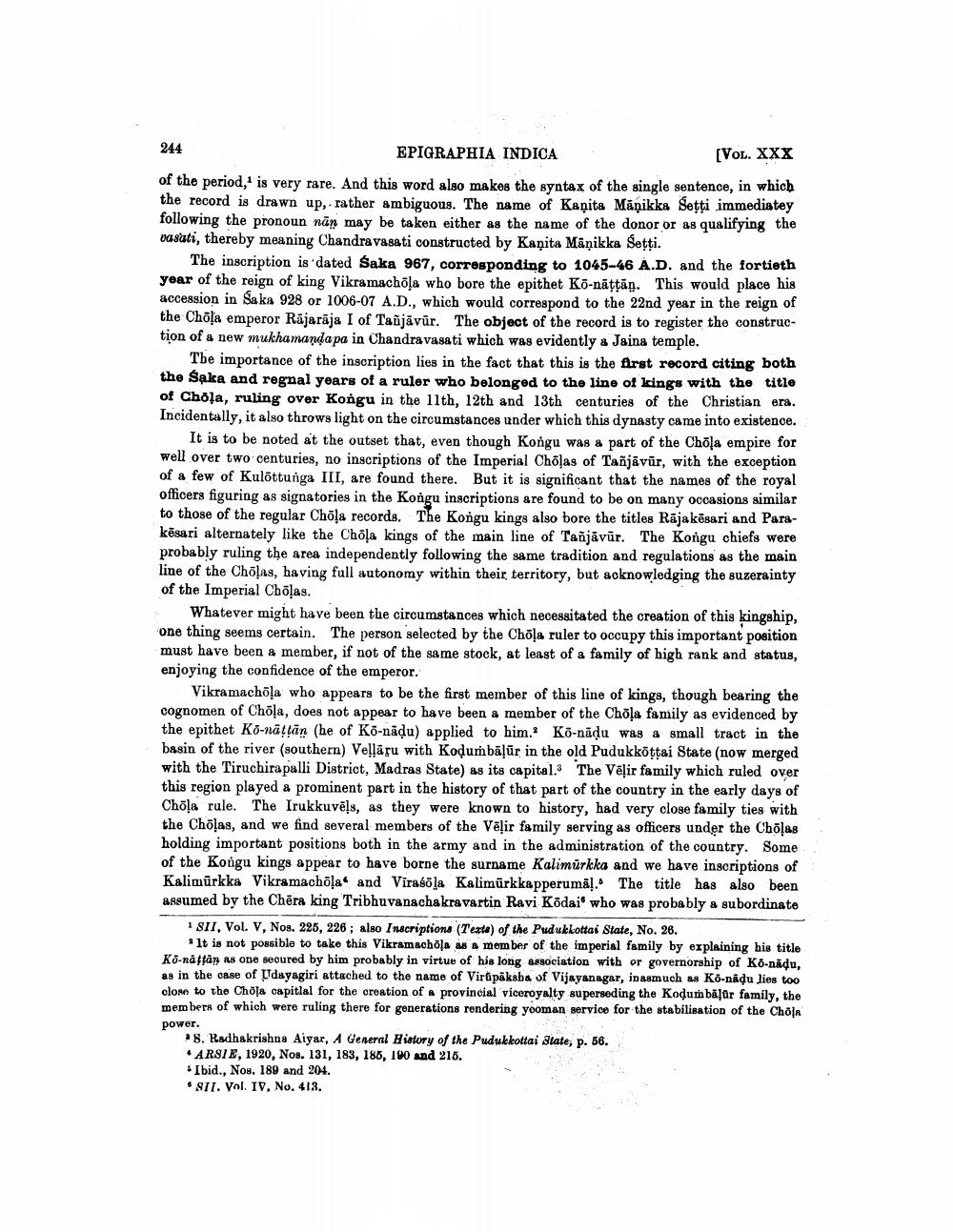________________
244 EPIGRAPHIA INDICA
[VOL. XXX of the period, is very rare. And this word also makes the syntax of the single sentence, in which the record is drawn up, rather ambiguous. The name of Kaņita Māņikka Sețți immediatey following the pronoun nān may be taken either as the name of the donor or as qualifying the vasati, thereby meaning Chandravasati constructed by Kaņita Mäņikka Setti.
The inscription is dated Saka 967, corresponding to 1045-46 A.D. and the fortieth year of the reign of king Vikramachõļa who bore the epithet Ko-nättän. This would place his accession in Saka 928 or 1006-07 A.D., which would correspond to the 22nd year in the reign of the Chola emperor Rajaraja I of Tañjāvūr. The object of the record is to register the construction of a new mukhamanda pa in Chandravasati which was evidently a Jaina temple.
The importance of the inscription lies in the fact that this is the first record citing both the Saka and regnal years of a ruler who belonged to the line of kings with the title of Chola, ruling over Kongu in the 11th, 12th and 13th centuries of the Christian era. Incidentally, it also throws light on the circumstances under which this dynasty came into existence.
It is to be noted at the outset that, even though Kongu was a part of the Chola empire for well over two centuries, no inscriptions of the Imperial Chõlas of Tañjāvūr, with the exception of a few of Kulottunga III, are found there. But it is significant that the names of the royal officers figuring as signatories in the Kongu inscriptions are found to be on many occasions similar to those of the regular Chöļa records. The Kongu kings also bore the titles Rājakēsari and Parakēsari alternately like the Chöļa kings of the main line of Tañjāvür. The Kongu chiefs were probably ruling the area independently following the same tradition and regulations as the main line of the Chöļas, having full autonomy within their territory, but acknowledging the suzerainty of the Imperial Cbõlas.
Whatever might have been the circumstances which necessitated the creation of this kingship, one thing seems certain. The person selected by the Chöļa ruler to occupy this important position must have been a member, if not of the same stock, at least of a family of high rank and status, enjoying the confidence of the emperor.
Vikramachöļa who appears to be the first member of this line of kings, though bearing the cognomen of Chõļa, does not appear to have been a member of the Chõla family as evidenced by the epithet Kö-nättan (he of Ko-nadu) applied to him. Kö-nādu was a small tract in the basin of the river (southern) Vellāfu with Kodumbāļūr in the old Pudukkottai State (now merged with the Tiruchirapalli District, Madras State) as its capital. The Vēļir family which ruled over this region played a prominent part in the history of that part of the country in the early days of Chõļa rule. The Irukkuvēls, as they were known to history, had very close family ties with the Cholas, and we find several members of the Vēļir family serving as officers under the Cholas holding important positions both in the army and in the administration of the country. Some of the Kongu kings appear to have borne the surname Kalimürkka and we have inscriptions of Kalimūrkka Vikramachola and Virasola Kalimürkkapperumal. The title has also been assumed by the Chēra king Tribhuvanachakravartin Ravi Kõdai who was probably & subordinate
1811, Vol. V, Nos. 225, 226 ; also Inscriptions (Texta) of the Pudukkottai State, No. 26.
* It is not possible to take this Vikramachola as a member of the imperial family by explaining his title Ko-naftan as one secured by him probably in virtue of his long association with or governorship of Kö-nädu, as in the case of Udayagiri attached to the name of Virupaksha of Vijayanagar, inasmuch as Ko-nādu lies too clone to the Chola capitlal for the creation of provincial viceroyalty superseding the Kodumbālur family, the members of which were ruling there for generations rendering yooman service for the stabilisation of the Chola power.
38. Radhakrishna Aiyar, A General History of the Pudukkottai State, p. 56. • ARSIE, 1920, Nos. 131, 183, 186, 190 and 216. • Ibid., Nos. 189 and 204. .SI1. Vol. IV, No. 413.




